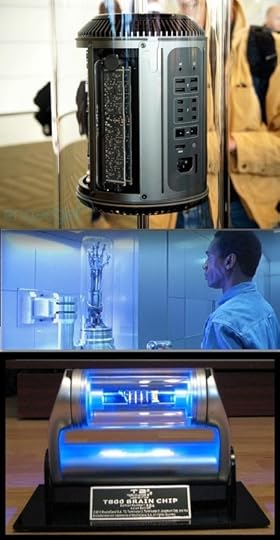C.J. Moseley's Blog, page 187
August 1, 2013
thedoubleclicks:
Yay! Delightful velociraptor song fanart…
Published on August 01, 2013 06:30
July 31, 2013
Science in Science-Fiction: Faster Than Light
It's a standard of science-fiction, so much so that in most movies and TV shows that call themselves science-fiction almost take it as read that Star drives are not impossible. Physicists aren't so sure as there are huge number of problems that the universe is going to throw in the way of us building Interstellar craft, but some aspects of theoretical physics are beginning to find ways around the laws that the Universe has put in our way.
Reaching for the Stars
[caption id="attachment_7350" align="alignright" width="300"] An Annotated Milky Way courtesy of NASA[/caption]
An Annotated Milky Way courtesy of NASA[/caption]
The stars are incredibly far away from us, and the galaxy is huge. Just to give you some idea how big our galaxy is think about this for a moment. The Milky Way is a barred spiral galaxy about a 110,000 light-years in diameter containing in the region of 300 billion stars. We live about two-thirds of the way out (that's 37,000 light-years or so) in the Orion Arm. Now a light-year is, as any ten-year-old science-fiction fan knows, a measurement of how far light can travel in one solar year (which is 5,878,499,810,000 miles or nearly 6 trillion in the short count and only 6 Billion in the long count or 9 and half billion/trillion kilometres) so the light from the Galactic core takes about 37,000 years to reach us from the super-massive black-hole Sagittarius A. This means that if our nearest neighbour (Proxima Centauri at 4.24 light-years away) and our sun were drawn on a map one inch apart the map of our Galaxy to scale would be 721 yards across and we'd be over 242 yards from the centre folds of the map. That's pretty big, and if we ever want to get out and explore that kind of distance even travelling at the speed of light is going to take us millions of years to explore it all (assuming we slow down and look at each system), a job best done by robots it would seem. So it seems simple then, if we ever want to go on holiday to Proxima Centauri we need to travel faster than light, since even light takes over 8 years to make the round trip. In fact to take a two week cruise out to Proxima Centauri would require our luxury space yacht to travel at at least 220 times the speed of light to get there and back in a fortnight.
Relativity for beginners.
Albert Einstein was a clever chap, perhaps you've heard of him. As physicists go he's probably the most famous example, and there are good reasons for this. For one he quite liked fame and had a quirky sense of humour that went over well with the media in the early Twentieth century; for another he was extraordinarily clever and basically worked out how the entire universe worked one morning on the tram to work. At least that's how the story goes.
[caption id="attachment_7352" align="alignleft" width="222"] Sat aboard a very similar tram, Einstein pondered the very nature of reality.[/caption]
Sat aboard a very similar tram, Einstein pondered the very nature of reality.[/caption]
Albert was basically wondering what the world would look like if you were riding a photon (a particle of light) or a tram travelling at the speed of light. He realised that since we rely on light to see the universe it would look like everything had stopped, that time was standing still. What's more he realised that as far as the person watching him flying away would see him apparently frozen in time too. This apparent paradox lead him to delve into some hefty maths, and in the process formulate new ways of thinking about time and space and how they interact with mass.
It took him some time but he worked out rules for this bizarre interpretation of reality, which have since been validated (if not actually proven) by experimentation. They include:
Space and time are not separated but are one space-time continuum. You can consider time as a dimension.
Spacetime is not absolute it bends, distorts, stretches and dilates.
The speed of light is always the speed of light, it doesn't matter how fast you are travelling when you measure it, or how fast the light source is travelling the emitted rays of light travel at the same speed.
E=mc² or that is the Energy of a body at rest is equal to the mass of the body multiplied by the speed of light multiplied by the speed of light - which as it turns out is very important.
Objects that are moving cannot be measured the same as bodies at rest. Motion contracts the length of an object in the direction of travel and a moving body has a greater inertial mass than at rest.
Possibly the most interesting thing about all of Einstein's theory is that all of these states get worse the closer to the speed of light that the body is travelling. So at 99% of the speed of light a space craft is compressed heavily in the direction of travel and has a mass many times its rest mass and time would seem to be slowed aboard the spaceship to almost a crawl. If you'd like to know more about exactly how much 99% of c has you can go here and find out for yourself (go on I'll wait)...
In Sci-Fi it is often assumed that just getting close to the speed of light is enough, after all at 0.99c time is moving at one seventh it's normal rate (you checked right?), so a distance that takes the ship fourteen years to travel will feel like only two to the crew. In fact as early as 1930 (Miles Breuer's " The Fitzgerald Contraction ") this particular trick was doing the rounds, and is the founding plot twist (spoiler alert!) for the original "Planet of the Apes" franchise. The time contraction keeps the crew alive for incredibly long periods of time if you can get close enough to the speed of light without crashing.
So if a space cruiser was accelerated all the way upto the speed of light it would have no length at all and weigh an infinite amount (yup, more than the entire universe) which would be pretty tricky to push. Also time on board the space vessel would effectively stop, there would be no time for course corrections or even for the fuel to burn to push us along. All of which is usually enough to make the more practical physicist throw his hands up in the air and declare the whole situation impossible, and indeed — for a chemical rocket — it is.
The problem is that things do move at close to, and perhaps even at the speed of light. We even have proof that some things are travelling faster than the speed of light (or at least they look like they were, I'll get to them). I can almost hear the physicists out there about to explode with objections, but I can silence them with a special word…
Singularities
[caption id="attachment_7354" align="alignright" width="300"]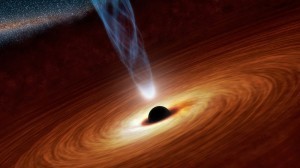 A blackhole as imagined by NASA[/caption]
A blackhole as imagined by NASA[/caption]
Singularities are special, they fell out of relativity almost as a proof against its validity. A singularity is a dimensionless point that has mass—but perhaps you know them by their other name: Black holes. Space-time near a black hole gets so twisted up and compressed by the singularity that even light is swallowed up (potentially some light may actually escape as Hawking radiation, but I digress). The black hole has an escape velocity greater than the speed of light, which means there's a place in space around the singularity where light will orbit the black hole and anything inside this 'event horizon' is trapped and travelling at the speed of light (at least).
We don't know what happens inside the event horizon, can't even guess with our current physics, but theories abound. My personal theory is that all the energy that falls into a black hole returns to the origin— the Big Bang —but it may form white holes that spew energy (as seen in the Red Dwarf episode "White Hole") or create wormholes, or parallel universes… the lists go on… but again I digress, the point is that gravity can accelerate a body to the speed of light, because gravity is just the bending of space. If space is bent to make something fall at the speed of light, perhaps it can be bent to let something fall faster than the speed of light…
Gravity drive
[caption id="" align="alignright" width="475"] No, I don't think the drive was meant to do that...[/caption]
No, I don't think the drive was meant to do that...[/caption]
Assuming we could create an artificial gravity generator we would have the necessary components to construct a gravity drive. Our model ship projects a gravity well in front of itself and falls towards it, because it uses gravity all parts of the ship would fall at the same rate and there would be no "g-forces" felt by the crew because they would be in free fall. This engine would allow the ship to accelerate and manoeuvre incredibly swiftly and to travel to a nearby star system in only a few years. In extremis the gravity drive creates a black-hole which opens a wormhole to another part of the universe, or hell.
Super-luminary bodies and Dark Energy
When Astrophysicists look out into deep space they see all manner of strange and startling bodies (there are so many posts waiting to be written here…), but they also see a lot of similarities. Everywhere we look there are galaxies and each one seems to be about the same, we can see how they have changed over time by comparing the ones far away with the ones that are closer, and this is what Astronomers tend to do, cataloguing what they find and building bigger, better telescopes and radio telescopes to look out deeper and farther back in time.
[caption id="attachment_7355" align="alignleft" width="300"]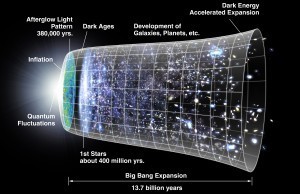 Expansion of the universe according to Astrophysics, image courtesy of NASA.[/caption]
Expansion of the universe according to Astrophysics, image courtesy of NASA.[/caption]
Because physics is a universal science, it doesn't just apply locally, what is true here on Earth is actually true beyond the limits of what we can see. This means we can look at stars and find a candle; a standard that we can use to compare galaxies and measure how far away they are and how they are moving (or accelerating). Luckily one particular type of star death always creates the exact same profile, our candle is a type 1 supernova. When we looked into the deepest time and space, at the earliest galaxies we got a shock. The candles were there just as predicted but the furthest galaxies were travelling away from us faster than the speed of light…
Physicists were horrified, but then theories appeared that made sense of it all and everyone calmed down again and went back to work. Space was inflating, that was all, actually some said we knew it was expanding, it had to from the Big Bang, so that's fine. These galaxies weren't really travelling at the speed of light, they were only doing about half that, the rest was optical illusion caused by spatial-inflation. If every metre between us and them had got bigger by the width of the average hydrogen atom that would more than explain the issue. They couldn't see the energy that was driving this inflation so they called it 'Dark Energy'. If we could control Dark Energy then we may be able to use it to inflate the space behind a craft, effectively pushing the ship forwards (I'm sure a whole wave of sci-fi writers are about to short-hand FTL drives as Dark Energy Drives).
Let's do the (Space-)Time-Warp again...
[caption id="attachment_7357" align="alignleft" width="300"]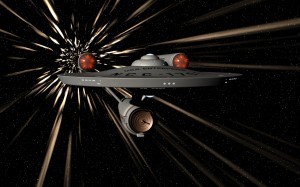 Whooosh![/caption]
Whooosh![/caption]
Did you get all that? Space can be compressed by Gravity and inflated by Dark Energy. If you do one in front and one behind then that would be the exact definition of the Star-Trek Warp drive that was used throughout the Star-Trek films and later TV series (previous to The Next Generation the Warp Drive had occasionally been described as a 'Time Warp [most notably in the Original Pilot 'The Cage'] that allowed faster-than-light travel which could also work).
That's right, real science (or at least real Physicist Miguel Alcubierre) does think that one day man may be able to boldly go whoosh where no one has gone before. The details of the Alcubierre Warp drive can be found on the web. The only real problems are the Anti-matter core necessary to liberate the literally oodles of energy required and some understanding of dark matter and dark energy that goes beyond pointing and crying (which is all modern physics can really manage) and possibly an exotic matter emitter or two... Well, no one ever said it was going to be easy...
In my Paradox War trilogy I describe the ships that use this drive method as 'Void-Runners', but Warp drives are quite common, and many 'FTL Drives' from early science-fiction appear to operate in a manner consistent with this technology.
Shortcuts & Wormholes
[caption id="attachment_4977" align="alignright" width="300"] I still don't see the worm...[/caption]
I still don't see the worm...[/caption]
I almost feel embarrassed trying to explain this one to any potential sci-fi fan, but here goes.
Think of space as an apple, all the stars and planets are arranged on the surface of the apple. Now an ant that wants to walk from one side of the apple to the other can crawl all the way around the surface, slugging along through space-time. But a worm could bore from one side to the other creating a wormhole that connects the two points in space with a shortcut. Sometimes in movies especially, the apple becomes a fabric, or piece of paper and the worm a needle or pencil, but we still refer to it as a wormhole.
Well, Einstein and some of his buddies looked into this and they found that teeny tiny wormholes might exist, and the right exotic matter and energy might let you inflate, stabilise and target the ends of the wormhole. It is sometimes known as the Einstein-Rosen bridge.
In science fiction these Wormhole drives go by a number of names, in some cases the wormhole transit is instantaneous, these are usually called 'Jump' drives, with variants like Hyper-Jump, FTL Jump, spatial warps, spatial folding, star-gates and so on. If the wormhole transition takes time then it is more normally a Warp Tunnel, Vortex manipulator or Sub-space conduit.
The most famous Wormhole drive is actually the Stargate of the movie and various TV shows of the same name. Before that, it was examined in the end of the Disney Movie "Flatland may describe the rest of the cube as being wrapped up, looking at the plane sticking through the cube in three-dimensions tells a rather different story.
Now in Sci-Fi the story goes like this, a drive is developed that let's a ship transit up and down in the hyper-volume, in one particular place they find a special analogue of our universe, only everything there is still very close together, the Big Bang did not inflate everything in this hyper-spatial variant. So if you go there and travel quite short distances in this hyper-space when you come back you have actually travelled a very long way.
[caption id="attachment_4875" align="alignright" width="256"] This might be what a rotating tesseract looks like... but then again it might not.[/caption]
This might be what a rotating tesseract looks like... but then again it might not.[/caption]
Of course, there are lots of variations on the exact mechanism and description, but in general, hyperspace is a parallel space-time where interstellar distances are shrunk, or relativity does not apply, allowing super-luminary speed, or there exist currents that connect stars. It also can have a lot of different names, overspace, subspace, nulspace, and warpspace to list a few.
Hyperspace is so common in Sci-Fi that you don't really need to define it for your readers, it is enough to say Hyper-Drive, hyperspace jump or similar, everyone knows what you mean, and often expect a few common factors such as.
Most energy is used entering Hyperspace, not travelling in it, so you have to charge the engines for a jump.
Calculating a jump is tricky as Hyperspace is odd.
You can't fly hyperspace by the seat of your pants.
Things exist and even live in Hyperspace
Mass has a gravity shadow that extends into Hyperspace and makes it very tricky to enter and exit hyperspace near a planet or star.
Hyperspace portals need more energy than small ships can generate.
You can build a Gate that opens portal into hyperspace that smaller ships can use (although this can cause confusion with Wormhole style Stargates).
Often, because of the strange nature of hyperspace you cannot manoeuvre there effectively and must rely on calculating a trajectory, accelerating and then slipping over to hyper-space to coast along. This can lead to hyper-space being described as a 'jump' or 'hop' where the ship must make a series of such jumps each of several light-years in length to home in on their target star.
Here are just a few fictional hyper-space drives: Isaac Asimov's Foundation series, Frederik Pohl's " The Mapmakers ", almost everything by E.C. Tubb, and the " series which literally dismissed Einstein's theory and calculations.
To actually achieve FTL the Inertialess drive would have to replace the inertial mass of the vessel with an imaginary mass (in the mathematical sense of the imaginary number i or the square root of -1). Instantly the vessel would burst beyond the speed of light, converted into Tachyons (which probably don't exist, but were 'invented' [or postulated if you prefer] by Professor Gerald Feinberg), the only problem being converting Tachyons back into ordinary particles to decelerate at the other end.
Still the lack of predictive theory or evidence for their existence has not stopped them being used notable by Frederick Pohl and Jack Williamson in Farthest Star (and the rest of the series) where they used the system as a sort of matter transmitter (beam me up!) between the stars.
…And The Rest
That's it really for FTL, there are more ideas out there, but they tend to rely of daftness and the drives of the plot more than those of physics. So I'll only mention Harry Harrison's '' Infinite Improbability drive and leave it at that…
Next Month I'm going to talk about how we might power the ships...
Reaching for the Stars
[caption id="attachment_7350" align="alignright" width="300"]
 An Annotated Milky Way courtesy of NASA[/caption]
An Annotated Milky Way courtesy of NASA[/caption]The stars are incredibly far away from us, and the galaxy is huge. Just to give you some idea how big our galaxy is think about this for a moment. The Milky Way is a barred spiral galaxy about a 110,000 light-years in diameter containing in the region of 300 billion stars. We live about two-thirds of the way out (that's 37,000 light-years or so) in the Orion Arm. Now a light-year is, as any ten-year-old science-fiction fan knows, a measurement of how far light can travel in one solar year (which is 5,878,499,810,000 miles or nearly 6 trillion in the short count and only 6 Billion in the long count or 9 and half billion/trillion kilometres) so the light from the Galactic core takes about 37,000 years to reach us from the super-massive black-hole Sagittarius A. This means that if our nearest neighbour (Proxima Centauri at 4.24 light-years away) and our sun were drawn on a map one inch apart the map of our Galaxy to scale would be 721 yards across and we'd be over 242 yards from the centre folds of the map. That's pretty big, and if we ever want to get out and explore that kind of distance even travelling at the speed of light is going to take us millions of years to explore it all (assuming we slow down and look at each system), a job best done by robots it would seem. So it seems simple then, if we ever want to go on holiday to Proxima Centauri we need to travel faster than light, since even light takes over 8 years to make the round trip. In fact to take a two week cruise out to Proxima Centauri would require our luxury space yacht to travel at at least 220 times the speed of light to get there and back in a fortnight.
Relativity for beginners.
Albert Einstein was a clever chap, perhaps you've heard of him. As physicists go he's probably the most famous example, and there are good reasons for this. For one he quite liked fame and had a quirky sense of humour that went over well with the media in the early Twentieth century; for another he was extraordinarily clever and basically worked out how the entire universe worked one morning on the tram to work. At least that's how the story goes.
[caption id="attachment_7352" align="alignleft" width="222"]
 Sat aboard a very similar tram, Einstein pondered the very nature of reality.[/caption]
Sat aboard a very similar tram, Einstein pondered the very nature of reality.[/caption]Albert was basically wondering what the world would look like if you were riding a photon (a particle of light) or a tram travelling at the speed of light. He realised that since we rely on light to see the universe it would look like everything had stopped, that time was standing still. What's more he realised that as far as the person watching him flying away would see him apparently frozen in time too. This apparent paradox lead him to delve into some hefty maths, and in the process formulate new ways of thinking about time and space and how they interact with mass.
It took him some time but he worked out rules for this bizarre interpretation of reality, which have since been validated (if not actually proven) by experimentation. They include:
Space and time are not separated but are one space-time continuum. You can consider time as a dimension.
Spacetime is not absolute it bends, distorts, stretches and dilates.
The speed of light is always the speed of light, it doesn't matter how fast you are travelling when you measure it, or how fast the light source is travelling the emitted rays of light travel at the same speed.
E=mc² or that is the Energy of a body at rest is equal to the mass of the body multiplied by the speed of light multiplied by the speed of light - which as it turns out is very important.
Objects that are moving cannot be measured the same as bodies at rest. Motion contracts the length of an object in the direction of travel and a moving body has a greater inertial mass than at rest.
Possibly the most interesting thing about all of Einstein's theory is that all of these states get worse the closer to the speed of light that the body is travelling. So at 99% of the speed of light a space craft is compressed heavily in the direction of travel and has a mass many times its rest mass and time would seem to be slowed aboard the spaceship to almost a crawl. If you'd like to know more about exactly how much 99% of c has you can go here and find out for yourself (go on I'll wait)...
In Sci-Fi it is often assumed that just getting close to the speed of light is enough, after all at 0.99c time is moving at one seventh it's normal rate (you checked right?), so a distance that takes the ship fourteen years to travel will feel like only two to the crew. In fact as early as 1930 (Miles Breuer's " The Fitzgerald Contraction ") this particular trick was doing the rounds, and is the founding plot twist (spoiler alert!) for the original "Planet of the Apes" franchise. The time contraction keeps the crew alive for incredibly long periods of time if you can get close enough to the speed of light without crashing.
So if a space cruiser was accelerated all the way upto the speed of light it would have no length at all and weigh an infinite amount (yup, more than the entire universe) which would be pretty tricky to push. Also time on board the space vessel would effectively stop, there would be no time for course corrections or even for the fuel to burn to push us along. All of which is usually enough to make the more practical physicist throw his hands up in the air and declare the whole situation impossible, and indeed — for a chemical rocket — it is.
The problem is that things do move at close to, and perhaps even at the speed of light. We even have proof that some things are travelling faster than the speed of light (or at least they look like they were, I'll get to them). I can almost hear the physicists out there about to explode with objections, but I can silence them with a special word…
Singularities
[caption id="attachment_7354" align="alignright" width="300"]
 A blackhole as imagined by NASA[/caption]
A blackhole as imagined by NASA[/caption]Singularities are special, they fell out of relativity almost as a proof against its validity. A singularity is a dimensionless point that has mass—but perhaps you know them by their other name: Black holes. Space-time near a black hole gets so twisted up and compressed by the singularity that even light is swallowed up (potentially some light may actually escape as Hawking radiation, but I digress). The black hole has an escape velocity greater than the speed of light, which means there's a place in space around the singularity where light will orbit the black hole and anything inside this 'event horizon' is trapped and travelling at the speed of light (at least).
We don't know what happens inside the event horizon, can't even guess with our current physics, but theories abound. My personal theory is that all the energy that falls into a black hole returns to the origin— the Big Bang —but it may form white holes that spew energy (as seen in the Red Dwarf episode "White Hole") or create wormholes, or parallel universes… the lists go on… but again I digress, the point is that gravity can accelerate a body to the speed of light, because gravity is just the bending of space. If space is bent to make something fall at the speed of light, perhaps it can be bent to let something fall faster than the speed of light…
Gravity drive
[caption id="" align="alignright" width="475"]
 No, I don't think the drive was meant to do that...[/caption]
No, I don't think the drive was meant to do that...[/caption]Assuming we could create an artificial gravity generator we would have the necessary components to construct a gravity drive. Our model ship projects a gravity well in front of itself and falls towards it, because it uses gravity all parts of the ship would fall at the same rate and there would be no "g-forces" felt by the crew because they would be in free fall. This engine would allow the ship to accelerate and manoeuvre incredibly swiftly and to travel to a nearby star system in only a few years. In extremis the gravity drive creates a black-hole which opens a wormhole to another part of the universe, or hell.
Super-luminary bodies and Dark Energy
When Astrophysicists look out into deep space they see all manner of strange and startling bodies (there are so many posts waiting to be written here…), but they also see a lot of similarities. Everywhere we look there are galaxies and each one seems to be about the same, we can see how they have changed over time by comparing the ones far away with the ones that are closer, and this is what Astronomers tend to do, cataloguing what they find and building bigger, better telescopes and radio telescopes to look out deeper and farther back in time.
[caption id="attachment_7355" align="alignleft" width="300"]
 Expansion of the universe according to Astrophysics, image courtesy of NASA.[/caption]
Expansion of the universe according to Astrophysics, image courtesy of NASA.[/caption]Because physics is a universal science, it doesn't just apply locally, what is true here on Earth is actually true beyond the limits of what we can see. This means we can look at stars and find a candle; a standard that we can use to compare galaxies and measure how far away they are and how they are moving (or accelerating). Luckily one particular type of star death always creates the exact same profile, our candle is a type 1 supernova. When we looked into the deepest time and space, at the earliest galaxies we got a shock. The candles were there just as predicted but the furthest galaxies were travelling away from us faster than the speed of light…
Physicists were horrified, but then theories appeared that made sense of it all and everyone calmed down again and went back to work. Space was inflating, that was all, actually some said we knew it was expanding, it had to from the Big Bang, so that's fine. These galaxies weren't really travelling at the speed of light, they were only doing about half that, the rest was optical illusion caused by spatial-inflation. If every metre between us and them had got bigger by the width of the average hydrogen atom that would more than explain the issue. They couldn't see the energy that was driving this inflation so they called it 'Dark Energy'. If we could control Dark Energy then we may be able to use it to inflate the space behind a craft, effectively pushing the ship forwards (I'm sure a whole wave of sci-fi writers are about to short-hand FTL drives as Dark Energy Drives).
Let's do the (Space-)Time-Warp again...
[caption id="attachment_7357" align="alignleft" width="300"]
 Whooosh![/caption]
Whooosh![/caption]Did you get all that? Space can be compressed by Gravity and inflated by Dark Energy. If you do one in front and one behind then that would be the exact definition of the Star-Trek Warp drive that was used throughout the Star-Trek films and later TV series (previous to The Next Generation the Warp Drive had occasionally been described as a 'Time Warp [most notably in the Original Pilot 'The Cage'] that allowed faster-than-light travel which could also work).
That's right, real science (or at least real Physicist Miguel Alcubierre) does think that one day man may be able to boldly go whoosh where no one has gone before. The details of the Alcubierre Warp drive can be found on the web. The only real problems are the Anti-matter core necessary to liberate the literally oodles of energy required and some understanding of dark matter and dark energy that goes beyond pointing and crying (which is all modern physics can really manage) and possibly an exotic matter emitter or two... Well, no one ever said it was going to be easy...
In my Paradox War trilogy I describe the ships that use this drive method as 'Void-Runners', but Warp drives are quite common, and many 'FTL Drives' from early science-fiction appear to operate in a manner consistent with this technology.
Shortcuts & Wormholes
[caption id="attachment_4977" align="alignright" width="300"]
 I still don't see the worm...[/caption]
I still don't see the worm...[/caption]I almost feel embarrassed trying to explain this one to any potential sci-fi fan, but here goes.
Think of space as an apple, all the stars and planets are arranged on the surface of the apple. Now an ant that wants to walk from one side of the apple to the other can crawl all the way around the surface, slugging along through space-time. But a worm could bore from one side to the other creating a wormhole that connects the two points in space with a shortcut. Sometimes in movies especially, the apple becomes a fabric, or piece of paper and the worm a needle or pencil, but we still refer to it as a wormhole.
Well, Einstein and some of his buddies looked into this and they found that teeny tiny wormholes might exist, and the right exotic matter and energy might let you inflate, stabilise and target the ends of the wormhole. It is sometimes known as the Einstein-Rosen bridge.
In science fiction these Wormhole drives go by a number of names, in some cases the wormhole transit is instantaneous, these are usually called 'Jump' drives, with variants like Hyper-Jump, FTL Jump, spatial warps, spatial folding, star-gates and so on. If the wormhole transition takes time then it is more normally a Warp Tunnel, Vortex manipulator or Sub-space conduit.
The most famous Wormhole drive is actually the Stargate of the movie and various TV shows of the same name. Before that, it was examined in the end of the Disney Movie "Flatland may describe the rest of the cube as being wrapped up, looking at the plane sticking through the cube in three-dimensions tells a rather different story.
Now in Sci-Fi the story goes like this, a drive is developed that let's a ship transit up and down in the hyper-volume, in one particular place they find a special analogue of our universe, only everything there is still very close together, the Big Bang did not inflate everything in this hyper-spatial variant. So if you go there and travel quite short distances in this hyper-space when you come back you have actually travelled a very long way.
[caption id="attachment_4875" align="alignright" width="256"]
 This might be what a rotating tesseract looks like... but then again it might not.[/caption]
This might be what a rotating tesseract looks like... but then again it might not.[/caption]Of course, there are lots of variations on the exact mechanism and description, but in general, hyperspace is a parallel space-time where interstellar distances are shrunk, or relativity does not apply, allowing super-luminary speed, or there exist currents that connect stars. It also can have a lot of different names, overspace, subspace, nulspace, and warpspace to list a few.
Hyperspace is so common in Sci-Fi that you don't really need to define it for your readers, it is enough to say Hyper-Drive, hyperspace jump or similar, everyone knows what you mean, and often expect a few common factors such as.
Most energy is used entering Hyperspace, not travelling in it, so you have to charge the engines for a jump.
Calculating a jump is tricky as Hyperspace is odd.
You can't fly hyperspace by the seat of your pants.
Things exist and even live in Hyperspace
Mass has a gravity shadow that extends into Hyperspace and makes it very tricky to enter and exit hyperspace near a planet or star.
Hyperspace portals need more energy than small ships can generate.
You can build a Gate that opens portal into hyperspace that smaller ships can use (although this can cause confusion with Wormhole style Stargates).
Often, because of the strange nature of hyperspace you cannot manoeuvre there effectively and must rely on calculating a trajectory, accelerating and then slipping over to hyper-space to coast along. This can lead to hyper-space being described as a 'jump' or 'hop' where the ship must make a series of such jumps each of several light-years in length to home in on their target star.
Here are just a few fictional hyper-space drives: Isaac Asimov's Foundation series, Frederik Pohl's " The Mapmakers ", almost everything by E.C. Tubb, and the " series which literally dismissed Einstein's theory and calculations.
To actually achieve FTL the Inertialess drive would have to replace the inertial mass of the vessel with an imaginary mass (in the mathematical sense of the imaginary number i or the square root of -1). Instantly the vessel would burst beyond the speed of light, converted into Tachyons (which probably don't exist, but were 'invented' [or postulated if you prefer] by Professor Gerald Feinberg), the only problem being converting Tachyons back into ordinary particles to decelerate at the other end.
Still the lack of predictive theory or evidence for their existence has not stopped them being used notable by Frederick Pohl and Jack Williamson in Farthest Star (and the rest of the series) where they used the system as a sort of matter transmitter (beam me up!) between the stars.
…And The Rest
That's it really for FTL, there are more ideas out there, but they tend to rely of daftness and the drives of the plot more than those of physics. So I'll only mention Harry Harrison's '' Infinite Improbability drive and leave it at that…
Next Month I'm going to talk about how we might power the ships...
Published on July 31, 2013 17:20
July 29, 2013
Summer Holiday lack of admin blues
Currently I’m away from home on what we Brits like to call a Summer Holiday (other English speaking nations may …

Published on July 29, 2013 04:19
July 15, 2013
Working on short stories…
Today I have been mostly working on polishing up two short stories.
Further Information - what would you write in the Further Information box of your job application to join a Demon hunting guild? Perhaps the story of how you already helped defeat one?
Morning Monsters - the creepy tale of working aboard a lonely space station.
If anyone would like a sneak peek and pass me some critical insight, I will send you a copy if you comment here or on twitter. After I've had some feedback, made some changes and produced a couple of covers I will be selling them for $0.99 on Amazon.com and £0.77 on Amazon.co.uk. If I get enough responses I might even post them here for free for a while...
Further Information - what would you write in the Further Information box of your job application to join a Demon hunting guild? Perhaps the story of how you already helped defeat one?
Morning Monsters - the creepy tale of working aboard a lonely space station.
If anyone would like a sneak peek and pass me some critical insight, I will send you a copy if you comment here or on twitter. After I've had some feedback, made some changes and produced a couple of covers I will be selling them for $0.99 on Amazon.com and £0.77 on Amazon.co.uk. If I get enough responses I might even post them here for free for a while...
Published on July 15, 2013 05:31
July 12, 2013
Mind-Blowing Spaceships from 1970s British Paperbacks
Mind-Blowing Spaceships from 1970s British Paperbacks:
Nice- I’ve a few (dozens of) books I could do this with!
Paul McAuley is the author of The Quiet War, as well as Life After Wartime and Evening’s Empires. He’s also got an amazing collection of 1970s SF paperbacks, whose covers he’s just digitized to share with the world. Here’s his gallery of covers that feature spaceships done in a cool, psychedelic-minimalist style.
Published on July 12, 2013 00:43
July 3, 2013
Problems with my theme
It seems that the HTML5 and CSS3 elements of my site are causing problems with the latest version of Firefox (and the CCS animations are causing a memory leak in web-kit browsers - good job guys!). So I'm going to have to alter the theme. Because of time constraints (I'm trying to write a novel as well as blog here and look after two kids) I'm not sure when I'll be able to address these problems properly. So until then if you are having problems try adding ?theme=twentytwelve to the page url. I'll add a shortcut on the sidebar of the site.
Sorry about any problems this may cause.
-CJM
Sorry about any problems this may cause.
-CJM
Published on July 03, 2013 02:38
June 30, 2013
Science in Science-Fiction: Interplanetary Spacecraft part 2
Okay in part one I discussed various ways that we might get up out of a planetary atmosphere and into space, and we can be hopeful that eventually we'll have a space-elevator, orbital ring or launch loop, although I suspect they should be tried out first on the moon and later on mars where we will learn a little about their operation before one falls on Calcutta or Mexico City — but let's take that as read and we can get to orbit, what kinds of craft can we sail out into the deep in?
Sunjammers
[caption id="" align="alignleft" width="250"]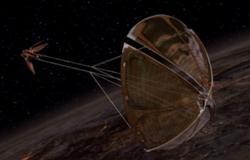 Count Dooku rode around in a Solar sailer in Star Wars, although it seemed a little nippier than the real thing.[/caption]
Count Dooku rode around in a Solar sailer in Star Wars, although it seemed a little nippier than the real thing.[/caption]
Well first and most poetic is a Sunjammer or solar sailer, not to be confused with the Solar Barge of Ra (which is the sun).
Invented for a story by the same man who invented communication satellites, Arthur C. Clarke (although other authors do seem to have come up with the idea separately). He imagined a sheet of metallic foil bigger than football field tied to your capsule with thin strong cables.
The solar wind, which consists of photons, electrons, neutrinos, alpha particles (and so on) hit the sail travelling at (or very close to) light-speed and push it, very very gently. This tiny push, across a huge enough sail can turn into enough thrust to allow us to sail out away from the sun, and with a bit of ingenuity and orbital mechanics it becomes possible to use the out flowing particles to decelerate your obit around the sun and descend inward.
Sounds great, it's very cheap and has the potential to shift huge masses around, but only at incredibly low accelerations.
NASA is testing this, even giving it a good try with a technology demonstrator due to fly in 2014. That tiny level of thrust is useful for preserving an orbit or slowly sailing in or out, but for humans to ever really sail these vessels about it's probably going to require enormous sails that can exert a few actual Newtons of force (at least). There is a possibility that we might be able to create some sort of magnetic sail hundreds of kilometres across, but that technology is hundreds of years (or one good genius jump) off yet.
So what else have we got?
Ion drive
[caption id="attachment_6779" align="alignright" width="300"]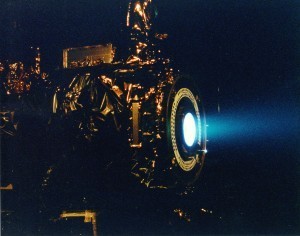 A working Ion Drive test firing from NASA JPL (via wikipedia)[/caption]
A working Ion Drive test firing from NASA JPL (via wikipedia)[/caption]
The ion drive (or more properly thruster) sometimes called a Plasma jet, is another rocket. Rather than burning chemicals the ion drive instead throws electrons or protons really quickly out of the back end to provide thrust.
In physics terms this elevates the Ion drive from chemical efficiency to electrical efficiency (which on paper is a very good thing). In real terms its a bit like like pointing a tiny machine gun backwards while wearing roller skates. Sounds great in theory, you can carry a lot more bullets if they are tiny, but each kick of the gun is weaker.
At the moment our best try can produce about half a Newton of force, but we can sustain that for thousands of hours at a time. Which again is great for pushing satellites around, but we need to spend a lot (of time and money) perfecting these before we'll be riding plasma tailed rockets through the firmament.
In science-fiction the Ion drive is a regular staple and you'll find it turns up all over the place, as the sub-light drive of choice, everywhere from Star Wars to the Impulse drive of Star Trek (although that is technically a magnetoplasmadynamic thruster which still produces an ionic exhaust. Most often the variation used is the ultra-cool sounding Plasma Drive, presumably powered by a Fusion reactor.
Pulse detonation thermonuclear drive
Back in the 1940s when mankind was thinking big after World War II, one Stanislaw Marcin Ulam, who worked at Los Alamos on the Manhattan Project and may have been the man behind the technological singularity as a concept, had a brilliant idea.
What if a rocket rode a series of explosions rather than one continuous one, and then just to make it faster (and safer- weirdly) lets make the explosions atomic or even thermonuclear bombs. The idea was fleshed out during the 1950s and called Project Orion, which is why they are sometimes referred to as Orion drives.
The idea of riding bomb explosions to the stars turns up quite a lot in sci-fi, any time the science gets hard and you are talking about generation ships, or ships to get out beyond Jupiter in fact, you'll often find Orion drives are the go to drive. They even turn up in Star Trek (original series series 3 episode 8 : "For the World is Hollow and I Have Touched the Sky") with a convenient asteroid ship.
[caption id="attachment_6973" align="alignright" width="300"] The Messiah from 'Deep Impact is described as an Orion drive vessel, but the geniuses at ILM just strapped some boosters together with a shuttle cab for the special effects shots.[/caption]
The Messiah from 'Deep Impact is described as an Orion drive vessel, but the geniuses at ILM just strapped some boosters together with a shuttle cab for the special effects shots.[/caption]
Whilst it may sound like a crazy Sci-Fi idea, they actually did do a lot of the planning and everything looked good for the Orion design, until nuclear test treaties banned the use of nuclear weapons in space, so even if it is a good idea, it has been banned already. At least until we need to use one to get to that incoming Deep Impacter Asteroid like the one from this movie. Then it will probably turn out some Space-Agency or Air Force has secretly been keeping the technology up to date, at least it always does in the movies. Which brings us to another banned technology.
Torch ships
Torch ships were a favourite of early science-fiction authors, particularly Robert Heinlein. The early concept of a Torch ship (As discussed in Rocket Ship Galileo) is simply a nuclear reactor where you pour a reaction mass such as water or molten lithium or even lead into the reactor. This heats up quick and rather than trying to contain the resultant hot gas, you let it come out of nozzles and turn it into thrust. Of course, that hot exhaust gas has a significant problem, its highly radioactive.
Later versions of the Torchship moved to a cleaner system of matter annihilation which may or may not have been based on Anti-matter, but could still take on almost anything as reaction mass, but water was the usual "fuel" the desperate heroes had to source.
Actually doing the maths seems to prove that the original Torch-ship concept isn't actually as efficient as the nuclear propulsion proposal of Project Orion, and the Ion drive is actually a more efficient use of the energy, so they're pretty much off the cards, but there is another option.
Laser Drive
Technically the laser doesn't actually propel the space ship it just vaporizes a reaction mass so that it expands explosively pushing out away from the ship exactly like a rocket. It's just that you can use anything, ice, rock even metal as a propellant if your laser is powerful enough.
The laser drive has many of the good points of an ion drive, it can be easily turned off and on, can be pulsed to conserve reaction mass, the laser can also ionise the explosion allowing for a hybrid engine that can act as an ion drive for months before finally applying higher accelerations by volatilising the propellant.
In this mode it has all of the advantages of the chemical drive in that huge amounts of thrust can be generated from the reaction mass. It also has the problems of chemical rockets in that huge amounts of reaction mass can be consumed quickly.
The laser ion drive has hope, but that powerful a laser also requires a power source and we'll have to see what we can do about that…
One possibility is to mount big lasers in place on the moon (or in orbit) and shoot at the ships hitting their reaction masses from a distance and potentially using one laser to propel all out-bound traffic and decelerate inbound. Of course, a laser powerful enough to vaporise the reaction mass could just as easily destroy the ship if it missed…
Project Daedalus
[caption id="attachment_6975" align="alignright" width="300"]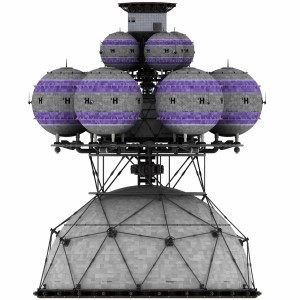 Orthographic image of Project Daedalus from www.icarusinterstellar.com[/caption]
Orthographic image of Project Daedalus from www.icarusinterstellar.com[/caption]
One variant of the laser drive is the idea behind the British Interplanetary Society's Project Daedalus, which combines the efficiency of an Ion drive with the canned craziness of Project Orion. A high energy beam contains and detonates a pellet of deuterium that explodes as a small fusion bomb pushing the ship. The idea was so good that Projects Longshot and Project Icarus were also designed around this engine concept.
This fusion bomb/laser combination has advantages over the Orion drive in that the fusion bomb is not quite as radioactive as a fissile device (or even a fissile triggered thermonuclear device), but is still a little hotter than you'd probably like. You certainly wouldn't want to live near the launch site.
Daedalus/Longshot is still probably our best hope for interstellar travel. The tiny looking living space at the top of that model would actually be the largest thing we've ever launched (in its own right) with that lower dome being about the height of a Saturn V. Daedalus as a project is rather like designing a flying Chrysler building, although since each of the spheres contains the thousands of Fusion "pellets" (or bombs as we'd call them), perhaps its more like building a huge flying armoury to the stars...
In science-fiction laser fusion drives are fairly rare, or are considered a variation of the Orion Drive, and you might find giant generation ships cruising through deep space with Laser Fusion drives, but more often they will just be described as Orion drives.
Daedalus is of course still banned by that pesky test treaty, so unless there is a pressing need for us to reach for deep space quickly, we're never likely to build one. Of course the other small problem with the Daedalus is that the actual technology it is meant to work from has never actually been proven, although we are getting close now.
Gravity Drive
This is a purely hypothetical drive with none of the grounded physics of the above.
It may be possible to contort space ahead of a ship (or above it if you are trying to hover) and effectively cause the ship to fall in that direction. Although to really get this to work we need a better understanding of space-time, mass and the Higgs' field, but it does not seem impossible to suggest that space can be distorted in this way. Such vessels would appear to be capable of amazingly fast manoeuvres without placing undue stresses upon the frame or pilots as the gravity field would act uniformly across the craft.
Sometimes the Gravity drive is called an Anti-gravity drive, because it can negate gravity. Although technically an Anti-Gravity drive would be a slightly different thing (a gravitational pushing force).
Gravity drives are often thrown into the mix of science-fiction for alien spacecraft, particularly the flying saucers. As they do describe the sorts of behaviours that people observe UFOs engaging in (rapid high-G impossible turns and the like).
Into the deep
Well that's about it for space drives. At the moment we are limited to simple chemical rockets and basic ion drives and soon tiny solar sails. If we are going to exploit the resources of our solar system, and as a species move beyond the next asteroid strike wiping us out then we are going to need to invest in some of these technologies.
Technologically we are close to being able to assemble a Generation ship to begin the journey towards new worlds, but socially we are far from it. Mankind currently can't really contemplate the sacrifices required to leave Earth for even the Moon, or Mars, let alone journey's beyond the solar system. Although we might get to the point of building robot probes to explore another stellar system in the next hundred years or so, I don't think we are within sight of even extra-planetary colonies, let alone extra-solar. Although the flurry of exo-planet findings of the last decade does look good for us eventually being able to. It certainly looks more possible now than it did thirty years ago.
Being realistic though, I cannot see mankind moving to colonize other star systems without extreme pressures at home, like ecological collapse or impending disaster of some sort and strong investment by governments or very forward looking institutions. At least not unless someone creates a shortcut that will allow us to leap out to the stars. Next Month I'll write about what that Star Drive might be...
Sunjammers
[caption id="" align="alignleft" width="250"]
 Count Dooku rode around in a Solar sailer in Star Wars, although it seemed a little nippier than the real thing.[/caption]
Count Dooku rode around in a Solar sailer in Star Wars, although it seemed a little nippier than the real thing.[/caption]Well first and most poetic is a Sunjammer or solar sailer, not to be confused with the Solar Barge of Ra (which is the sun).
Invented for a story by the same man who invented communication satellites, Arthur C. Clarke (although other authors do seem to have come up with the idea separately). He imagined a sheet of metallic foil bigger than football field tied to your capsule with thin strong cables.
The solar wind, which consists of photons, electrons, neutrinos, alpha particles (and so on) hit the sail travelling at (or very close to) light-speed and push it, very very gently. This tiny push, across a huge enough sail can turn into enough thrust to allow us to sail out away from the sun, and with a bit of ingenuity and orbital mechanics it becomes possible to use the out flowing particles to decelerate your obit around the sun and descend inward.
Sounds great, it's very cheap and has the potential to shift huge masses around, but only at incredibly low accelerations.
NASA is testing this, even giving it a good try with a technology demonstrator due to fly in 2014. That tiny level of thrust is useful for preserving an orbit or slowly sailing in or out, but for humans to ever really sail these vessels about it's probably going to require enormous sails that can exert a few actual Newtons of force (at least). There is a possibility that we might be able to create some sort of magnetic sail hundreds of kilometres across, but that technology is hundreds of years (or one good genius jump) off yet.
So what else have we got?
Ion drive
[caption id="attachment_6779" align="alignright" width="300"]
 A working Ion Drive test firing from NASA JPL (via wikipedia)[/caption]
A working Ion Drive test firing from NASA JPL (via wikipedia)[/caption]The ion drive (or more properly thruster) sometimes called a Plasma jet, is another rocket. Rather than burning chemicals the ion drive instead throws electrons or protons really quickly out of the back end to provide thrust.
In physics terms this elevates the Ion drive from chemical efficiency to electrical efficiency (which on paper is a very good thing). In real terms its a bit like like pointing a tiny machine gun backwards while wearing roller skates. Sounds great in theory, you can carry a lot more bullets if they are tiny, but each kick of the gun is weaker.
At the moment our best try can produce about half a Newton of force, but we can sustain that for thousands of hours at a time. Which again is great for pushing satellites around, but we need to spend a lot (of time and money) perfecting these before we'll be riding plasma tailed rockets through the firmament.
In science-fiction the Ion drive is a regular staple and you'll find it turns up all over the place, as the sub-light drive of choice, everywhere from Star Wars to the Impulse drive of Star Trek (although that is technically a magnetoplasmadynamic thruster which still produces an ionic exhaust. Most often the variation used is the ultra-cool sounding Plasma Drive, presumably powered by a Fusion reactor.
Pulse detonation thermonuclear drive
Back in the 1940s when mankind was thinking big after World War II, one Stanislaw Marcin Ulam, who worked at Los Alamos on the Manhattan Project and may have been the man behind the technological singularity as a concept, had a brilliant idea.
What if a rocket rode a series of explosions rather than one continuous one, and then just to make it faster (and safer- weirdly) lets make the explosions atomic or even thermonuclear bombs. The idea was fleshed out during the 1950s and called Project Orion, which is why they are sometimes referred to as Orion drives.
The idea of riding bomb explosions to the stars turns up quite a lot in sci-fi, any time the science gets hard and you are talking about generation ships, or ships to get out beyond Jupiter in fact, you'll often find Orion drives are the go to drive. They even turn up in Star Trek (original series series 3 episode 8 : "For the World is Hollow and I Have Touched the Sky") with a convenient asteroid ship.
[caption id="attachment_6973" align="alignright" width="300"]
 The Messiah from 'Deep Impact is described as an Orion drive vessel, but the geniuses at ILM just strapped some boosters together with a shuttle cab for the special effects shots.[/caption]
The Messiah from 'Deep Impact is described as an Orion drive vessel, but the geniuses at ILM just strapped some boosters together with a shuttle cab for the special effects shots.[/caption]Whilst it may sound like a crazy Sci-Fi idea, they actually did do a lot of the planning and everything looked good for the Orion design, until nuclear test treaties banned the use of nuclear weapons in space, so even if it is a good idea, it has been banned already. At least until we need to use one to get to that incoming Deep Impacter Asteroid like the one from this movie. Then it will probably turn out some Space-Agency or Air Force has secretly been keeping the technology up to date, at least it always does in the movies. Which brings us to another banned technology.
Torch ships
Torch ships were a favourite of early science-fiction authors, particularly Robert Heinlein. The early concept of a Torch ship (As discussed in Rocket Ship Galileo) is simply a nuclear reactor where you pour a reaction mass such as water or molten lithium or even lead into the reactor. This heats up quick and rather than trying to contain the resultant hot gas, you let it come out of nozzles and turn it into thrust. Of course, that hot exhaust gas has a significant problem, its highly radioactive.
Later versions of the Torchship moved to a cleaner system of matter annihilation which may or may not have been based on Anti-matter, but could still take on almost anything as reaction mass, but water was the usual "fuel" the desperate heroes had to source.
Actually doing the maths seems to prove that the original Torch-ship concept isn't actually as efficient as the nuclear propulsion proposal of Project Orion, and the Ion drive is actually a more efficient use of the energy, so they're pretty much off the cards, but there is another option.
Laser Drive
Technically the laser doesn't actually propel the space ship it just vaporizes a reaction mass so that it expands explosively pushing out away from the ship exactly like a rocket. It's just that you can use anything, ice, rock even metal as a propellant if your laser is powerful enough.
The laser drive has many of the good points of an ion drive, it can be easily turned off and on, can be pulsed to conserve reaction mass, the laser can also ionise the explosion allowing for a hybrid engine that can act as an ion drive for months before finally applying higher accelerations by volatilising the propellant.
In this mode it has all of the advantages of the chemical drive in that huge amounts of thrust can be generated from the reaction mass. It also has the problems of chemical rockets in that huge amounts of reaction mass can be consumed quickly.
The laser ion drive has hope, but that powerful a laser also requires a power source and we'll have to see what we can do about that…
One possibility is to mount big lasers in place on the moon (or in orbit) and shoot at the ships hitting their reaction masses from a distance and potentially using one laser to propel all out-bound traffic and decelerate inbound. Of course, a laser powerful enough to vaporise the reaction mass could just as easily destroy the ship if it missed…
Project Daedalus
[caption id="attachment_6975" align="alignright" width="300"]
 Orthographic image of Project Daedalus from www.icarusinterstellar.com[/caption]
Orthographic image of Project Daedalus from www.icarusinterstellar.com[/caption]One variant of the laser drive is the idea behind the British Interplanetary Society's Project Daedalus, which combines the efficiency of an Ion drive with the canned craziness of Project Orion. A high energy beam contains and detonates a pellet of deuterium that explodes as a small fusion bomb pushing the ship. The idea was so good that Projects Longshot and Project Icarus were also designed around this engine concept.
This fusion bomb/laser combination has advantages over the Orion drive in that the fusion bomb is not quite as radioactive as a fissile device (or even a fissile triggered thermonuclear device), but is still a little hotter than you'd probably like. You certainly wouldn't want to live near the launch site.
Daedalus/Longshot is still probably our best hope for interstellar travel. The tiny looking living space at the top of that model would actually be the largest thing we've ever launched (in its own right) with that lower dome being about the height of a Saturn V. Daedalus as a project is rather like designing a flying Chrysler building, although since each of the spheres contains the thousands of Fusion "pellets" (or bombs as we'd call them), perhaps its more like building a huge flying armoury to the stars...
In science-fiction laser fusion drives are fairly rare, or are considered a variation of the Orion Drive, and you might find giant generation ships cruising through deep space with Laser Fusion drives, but more often they will just be described as Orion drives.
Daedalus is of course still banned by that pesky test treaty, so unless there is a pressing need for us to reach for deep space quickly, we're never likely to build one. Of course the other small problem with the Daedalus is that the actual technology it is meant to work from has never actually been proven, although we are getting close now.
Gravity Drive
This is a purely hypothetical drive with none of the grounded physics of the above.
It may be possible to contort space ahead of a ship (or above it if you are trying to hover) and effectively cause the ship to fall in that direction. Although to really get this to work we need a better understanding of space-time, mass and the Higgs' field, but it does not seem impossible to suggest that space can be distorted in this way. Such vessels would appear to be capable of amazingly fast manoeuvres without placing undue stresses upon the frame or pilots as the gravity field would act uniformly across the craft.
Sometimes the Gravity drive is called an Anti-gravity drive, because it can negate gravity. Although technically an Anti-Gravity drive would be a slightly different thing (a gravitational pushing force).
Gravity drives are often thrown into the mix of science-fiction for alien spacecraft, particularly the flying saucers. As they do describe the sorts of behaviours that people observe UFOs engaging in (rapid high-G impossible turns and the like).
Into the deep
Well that's about it for space drives. At the moment we are limited to simple chemical rockets and basic ion drives and soon tiny solar sails. If we are going to exploit the resources of our solar system, and as a species move beyond the next asteroid strike wiping us out then we are going to need to invest in some of these technologies.
Technologically we are close to being able to assemble a Generation ship to begin the journey towards new worlds, but socially we are far from it. Mankind currently can't really contemplate the sacrifices required to leave Earth for even the Moon, or Mars, let alone journey's beyond the solar system. Although we might get to the point of building robot probes to explore another stellar system in the next hundred years or so, I don't think we are within sight of even extra-planetary colonies, let alone extra-solar. Although the flurry of exo-planet findings of the last decade does look good for us eventually being able to. It certainly looks more possible now than it did thirty years ago.
Being realistic though, I cannot see mankind moving to colonize other star systems without extreme pressures at home, like ecological collapse or impending disaster of some sort and strong investment by governments or very forward looking institutions. At least not unless someone creates a shortcut that will allow us to leap out to the stars. Next Month I'll write about what that Star Drive might be...
Published on June 30, 2013 17:01
June 19, 2013
Iron Master RPG session 14/7/13
Ran an Iron Master session last Friday. I've been running a once monthly game for a few sessions now to help fill out the background of the Iron Master universe.
The sessions are set in an alternate 1960s where mankind never industrialised Iron production due to an ancient treaty with the Fæ, the European nobility got magick in return for the granting of titles to anyone with magick. During the 18th century an Alchemical Middle-class arose, Alchemical metals replaced Iron at the heart of industrialisation, and these strange alchemical metals allowed the British Empire to rise to formidable dominance for a while, before hubris, Martians and the Great War helped pull all of that apart.
In order to limit the impact of my PCs in building the universe I have initially started them out as kids, all with a "Work House Poor" Impoverished handicap (x11 or x12), but already they are talking about building giant mechs the size of islands when they are bigger (with death-rays in the frickin' eyes).
In a previous sessions they proved (accidentally with a toneloque pistol) that Iron can be alchemically purified, killed one of the Common Fæ (which may or may not have been a significant breach of the treaty), met one of my novels main characters, before he's risen up the ranks too far of the metropolitan police force (which helped me define him) and led me to create the 'Talbots' who are cynocelaphic-super-soldiers that were developed by the Germans and British during the Great War.
On Friday they got dragged over to Lord Sylva's hall (the "bad guy" of Iron Master) as he is hosting a week long hunt to celebrate the harvest festival (and of course the hand over from Seelie Court dominance to Unseelie in the secret Commonwealth).
Of course, the usual paranoia has them believing that Lord Sylva and some of the very Fæ that they encountered earlier are planning to hunt them too, which it may turn out is not too far from the truth (everyone is excited to learn that the drag hunt has a grand prize, for the best hunt, voted by the hunters)…
Meanwhile the party's potential Mages (who have been warned off mage-school) have also realised that Lord Sylva has a huge magical library that is going to be largely unguarded during the actual hunting periods…
To say nothing of the party's mad-scientist-in-training who has been promised a Tesla Corporation Plasma Pistol if he can keep the Mechanimal Wolves ticking over nicely until the big event… the next session should be fun!
The sessions are set in an alternate 1960s where mankind never industrialised Iron production due to an ancient treaty with the Fæ, the European nobility got magick in return for the granting of titles to anyone with magick. During the 18th century an Alchemical Middle-class arose, Alchemical metals replaced Iron at the heart of industrialisation, and these strange alchemical metals allowed the British Empire to rise to formidable dominance for a while, before hubris, Martians and the Great War helped pull all of that apart.
In order to limit the impact of my PCs in building the universe I have initially started them out as kids, all with a "Work House Poor" Impoverished handicap (x11 or x12), but already they are talking about building giant mechs the size of islands when they are bigger (with death-rays in the frickin' eyes).
In a previous sessions they proved (accidentally with a toneloque pistol) that Iron can be alchemically purified, killed one of the Common Fæ (which may or may not have been a significant breach of the treaty), met one of my novels main characters, before he's risen up the ranks too far of the metropolitan police force (which helped me define him) and led me to create the 'Talbots' who are cynocelaphic-super-soldiers that were developed by the Germans and British during the Great War.
On Friday they got dragged over to Lord Sylva's hall (the "bad guy" of Iron Master) as he is hosting a week long hunt to celebrate the harvest festival (and of course the hand over from Seelie Court dominance to Unseelie in the secret Commonwealth).
Of course, the usual paranoia has them believing that Lord Sylva and some of the very Fæ that they encountered earlier are planning to hunt them too, which it may turn out is not too far from the truth (everyone is excited to learn that the drag hunt has a grand prize, for the best hunt, voted by the hunters)…
Meanwhile the party's potential Mages (who have been warned off mage-school) have also realised that Lord Sylva has a huge magical library that is going to be largely unguarded during the actual hunting periods…
To say nothing of the party's mad-scientist-in-training who has been promised a Tesla Corporation Plasma Pistol if he can keep the Mechanimal Wolves ticking over nicely until the big event… the next session should be fun!
Published on June 19, 2013 12:56
June 15, 2013
phonesandgadgets:
The “new” Mac Pro… I don’t think we’re…
Published on June 15, 2013 06:30
June 14, 2013
carudamon119:
????????
ODAIBA TOKYO GUNDAM
Wow!
Published on June 14, 2013 06:30


